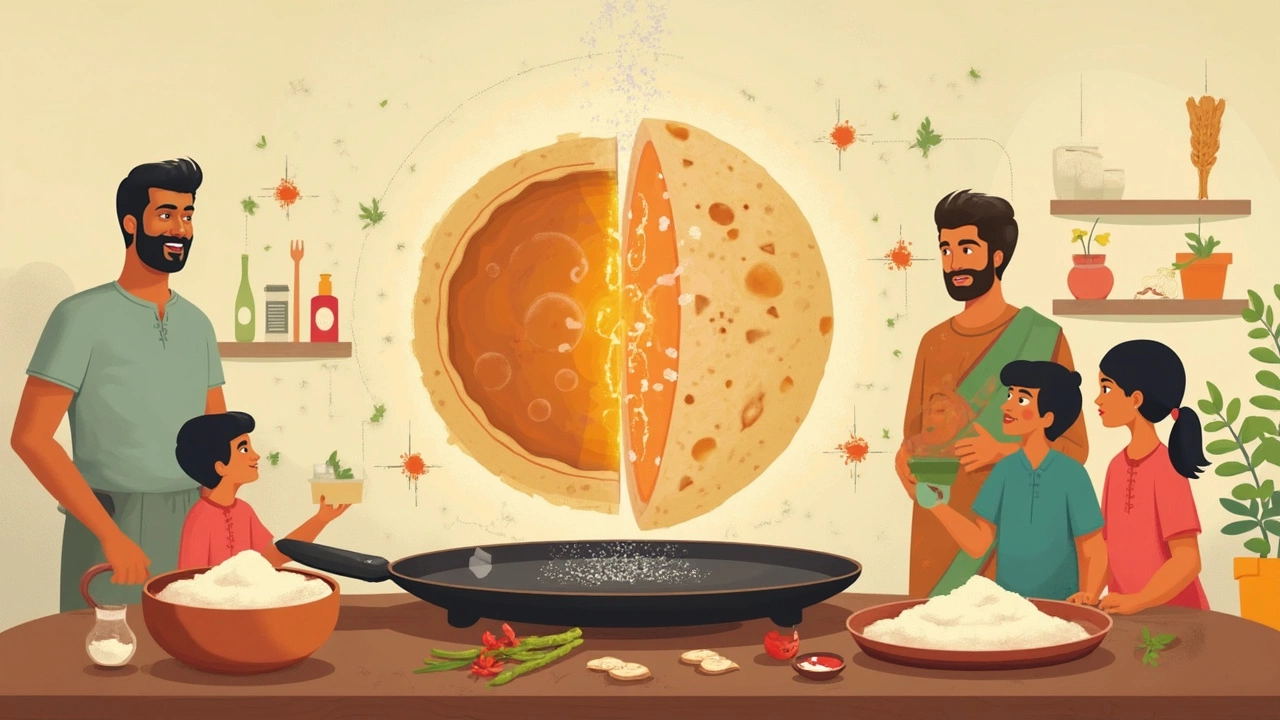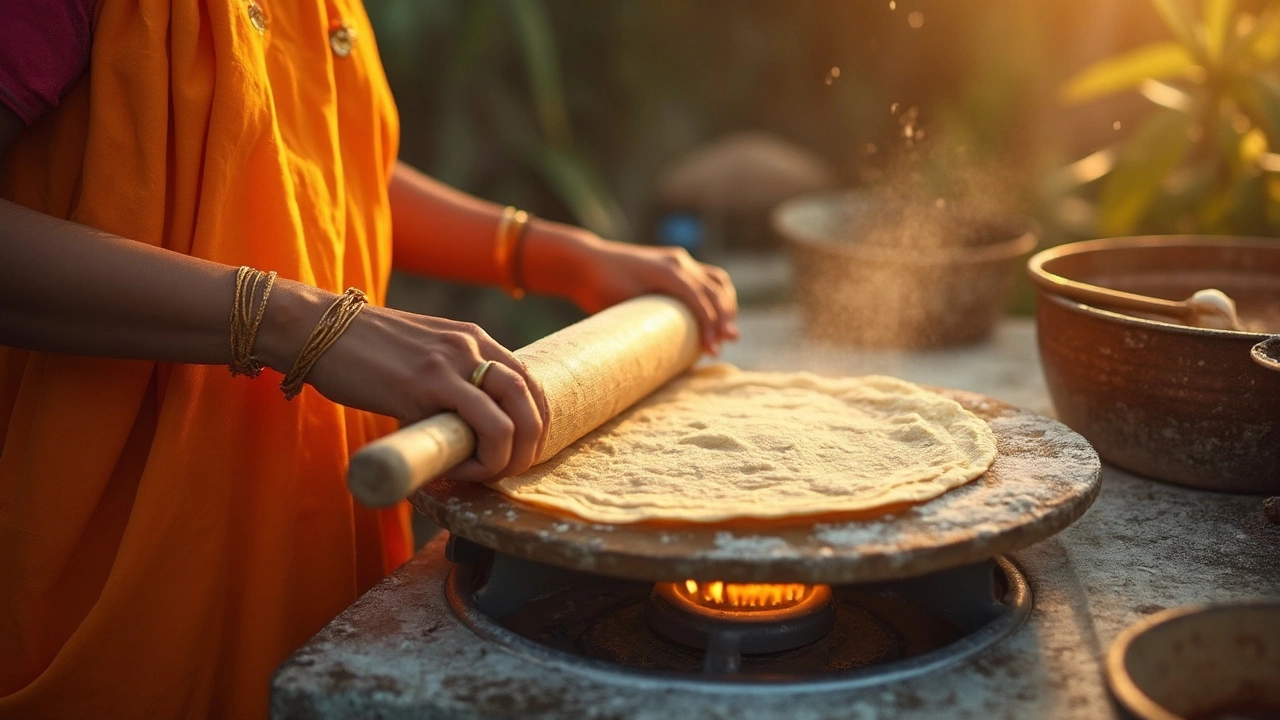Ever made roti and wondered why the best ones turn into little balloons? It's not magic—it's actually science, right there on your stovetop.
When you cook roti, it's carbon dioxide that causes all the puffing. This isn't something you pour in from a bottle, though. It forms naturally as you cook, all thanks to water in the dough turning into steam. That steam pushes out from the inside, making the roti puff and go soft. If your rotis don't puff, you're not alone—honestly, everyone struggles with this at first.
The cool part? You can tweak your technique to help that gas do its job. From kneading the dough just right, to making sure your pan is super hot, small changes make a huge difference. A bit of practice is all it takes. And if your rotis stay flat, it doesn't mean you're bad at this—you might just be missing one simple step.
- The Science Behind Fluffy Roti
- What Actually Creates the Gas?
- Kneading and Resting: Crucial Steps
- Cooking Technique: Timing and Temperature
- Troubleshooting: Why Isn't My Roti Puffing?
The Science Behind Fluffy Roti
Fluffy roti is all about what’s happening inside the dough, right on your pan. When you roll out a roti and put it on high heat, water in the dough starts turning into steam. This steam needs somewhere to go, so it builds up pressure and pushes the layers apart. That’s when you get those puffed-up, balloon-like rotis we all want. The main gas responsible for this is carbon dioxide, but here it's mostly water vapor doing the heavy lifting since you aren’t using yeast or baking powder.
The gluten you get from kneading the dough traps the steam. Think of gluten as stretchy nets that hold in the gas. If your dough isn’t kneaded well or is too dry, steam escapes and the roti stays flat. Too much water, and the dough is sticky without strength. Get that balance right, and you’re halfway to pillow-soft rotis.
Here’s how different factors impact how fluffy your roti gets:
- Kneading time: At least 7-10 minutes makes stronger gluten nets.
- Resting: Letting dough rest for 15-20 minutes relaxes the flour and makes rolling easier.
- Cooking temperature: The pan (tawa) needs to be very hot, around 230°C (450°F). Too low and nothing puffs; too high and it burns before puffing.
- Thickness: Even, not too thick – about the width of a coin.
Check out this basic breakdown of kneading and resting times from kitchen tests:
| Step | Time | Impact on Fluffiness |
|---|---|---|
| Kneading | 5 min | Okay, but some flat spots |
| Kneading | 10 min | Consistent puffing |
| Resting | 0 min | Patchy puffing |
| Resting | 20 min | Soft, fluffy rotis |
The heat, the kneading, and the water—these three things come together to trap the steam. That’s the secret behind every truly fluffy roti.
What Actually Creates the Gas?
If you’ve ever looked at your roti puffing up and thought, “What’s really happening in there?”—the answer isn’t mysterious. The main player is steam, not baking powder or yeast like in most breads. Here, heat hits the dough and the moisture inside starts to evaporate, turning into steam. That steam looks for any way to escape, and pushes against the dough. This is what makes your roti balloon up, fast.
But there’s another part to the story—carbon dioxide. It’s a tiny bit, but still important. When flour mixes with water, some natural enzyme activity and fermentation (even if you’re just resting the dough for 10-20 minutes) does make a little carbon dioxide. Most household rotis don’t rely on it the same way white bread does, but it helps with softness and texture.
Here’s a quick look at what’s happening:
- Heat hits the rolled-out dough
- Water in the dough turns into steam
- That steam tries to escape, but the outer layers of dough have sealed, so the steam gets trapped
- This trapped gas makes your roti puff up
These tiny science moments happen right on the stove, in seconds. If your dough is too dry or you skip resting, there’s less steam and you won’t get much of a puff.
| Factor | Role in Puffing |
|---|---|
| Water Content | More moisture means more steam, leading to fluffier roti. |
| Resting Dough | Loosens gluten and allows minimal CO2 to form, for better texture. |
| Heat Level | High heat leads to rapid steam production, causing the classic balloon effect. |
If you ever find your rotis staying flat, almost always it’s because of something in this process: too little water, not enough resting time, or a pan that’s not hot enough. Tweak these, and you’ll see a difference right away.

Kneading and Resting: Crucial Steps
If you skip proper kneading and resting, your roti can turn out tough and flat. The dough's texture depends on how you treat it before it hits the pan, so a bit of attention here goes a long way.
Kneading mixes the water evenly with the flour, letting the gluten form stretchy strands. This stretchiness is what lets the steam expand inside your roti, making it balloon up. You want a dough that's smooth, not too sticky, but not dry either. Think of it sort of like play-dough: squishy and easy to shape. Most people knead for 8–10 minutes. If your arms start to ache, you’re probably doing it right.
Resting is where a lot of us get impatient, but it matters just as much. Giving your dough at least 15–30 minutes to rest helps relax the gluten. This makes rolling easier and lets the roti puff up more during cooking. If you skip this, the dough pulls back when you roll it, and the steam can't do its thing.
| Step | Time Needed | Purpose | Common Mistake |
|---|---|---|---|
| Kneading | 8–10 mins | Build gluten, even moisture | Not enough kneading = tough roti |
| Resting | 15–30 mins | Relaxes gluten, easier rolling | Skipping rest = dough stretches back |
Here’s exactly how I do it at home to get fluffy roti every time:
- Knead the dough until it’s smooth and doesn’t stick much to your hands.
- Keep the dough covered with a damp cloth or plastic wrap while it rests, so it doesn’t dry out.
- Don’t rush the resting step—even a short 15-minute rest makes a difference.
Skipping these small things can mean the difference between a soft, puffy roti and a sad, chewy one. If you’ve tried everything else and still get flat rotis, look back at your kneading and resting routine. Odds are, the answer is right there.
Cooking Technique: Timing and Temperature
Alright, let’s get practical. You can have the best dough, but if your timing and temperature are off, your roti will never get fluffy. The roti needs that sudden blast of heat, or the steam inside won’t expand fast enough to puff it up. Most stoves work, but a really hot griddle (tava) is gold.
Here’s where people often mess up. If your pan’s not hot enough, the dough dries out before the roti even has a chance to puff. Too hot, and it burns before you see any balloon action. You want a sweet spot: think about 230-250°C (450-480°F) for the pan. That’s the typical range where rotis rise nicely.
- Heat up the griddle before you start cooking. Splash a drop of water—if it sizzles and disappears in seconds, you’re good.
- Roll your dough into an even circle, not too thick, not too thin (about 2mm is perfect).
- Toss the roti on the hot pan, leave it untouched for 20-30 seconds until you see small bubbles.
- Flip it, and wait another 20-25 seconds. Bubbles should start growing.
- Now, cook the last side straight over the flame using tongs, and this is where you see it puff up fast.
Here’s a quick look at how time and temperature affect puffing:
| Griddle Temperature | Time per Side | Puffing Success Rate |
|---|---|---|
| 200°C (392°F) | 40-50 sec | Low |
| 230°C (446°F) | 20-25 sec | High |
| 260°C (500°F) | 10-15 sec | Medium (burns quickly) |
If you skip the direct flame at the end, the roti often stays half-puffed. That last bit of heat shocks the steam, sending it racing out and blowing up the roti. Try this even if you’re using an electric stove—move the pan to the hottest spot or use a grill rack. If you nail the timing and temperature, you’ll have roti that balloons every single time—no mystery, just a bit of kitchen science and practice.

Troubleshooting: Why Isn't My Roti Puffing?
We've all been there—standing over the stove, waiting for that roti to puff up, and... nothing. So what really stops it from transforming into that perfect, round pocket? Let's break down the main reasons and what you can do about them.
Fluffy roti mostly comes down to dough, moisture, heat, and rolling. Miss the mark on any of these and you'll end up with flatbread instead of a puffed roti. Here's what could be going wrong:
- Dough is Too Dry or Too Wet: If your dough cracks when you roll it, it's too dry. Sticky and impossible to handle? Too wet. Aim for a soft dough that doesn't stick to your hands.
- Not Kneading Enough: Under-kneaded dough can't trap steam. Try kneading for at least 6-8 minutes for best results.
- Dough Not Rested: Skipping the 15-30 minute resting time keeps the gluten tight, which means less puff.
- Uneven Rolling: Thick edges or a lopsided disc let steam escape. Roll the roti evenly and not too thick—about 2mm is ideal.
- Insufficient Heat: If the pan isn’t hot enough (aim for around 260°C/500°F), steam won’t build up inside and the roti stays flat. Test the pan with a drop of water; it should sizzle and disappear fast.
- Cooking Too Long on One Side: If you overcook the first side, you lose moisture, and there’s no steam left to puff things up on the second side.
Check this quick table to spot common problems and fixes:
| Problem | What You'll Notice | Easy Fix |
|---|---|---|
| Dough too dry | Roti cracks while rolling | Add a splash of water during kneading |
| Dough not rested | Roti is tough, doesn't puff | Rest covered for 20 min |
| Low heat | Flat, dense roti | Increase stove heat; use highest setting |
| Irregular rolling | Parts puff, parts stay flat | Practice rolling to even thickness |
| Cooking too long before flipping | Dry, brittle roti | Flip after 10-15 seconds on first side |
If you fix these basics, rotis will almost always puff up. Still struggling? Try covering the dough with a damp cloth while it rests to keep it soft. Some folks even use a kitchen towel to gently press the roti while it's on the hot pan, especially for that last push if it's stubborn. Remember, everyone starts with flat rotis—practice truly makes a difference!
